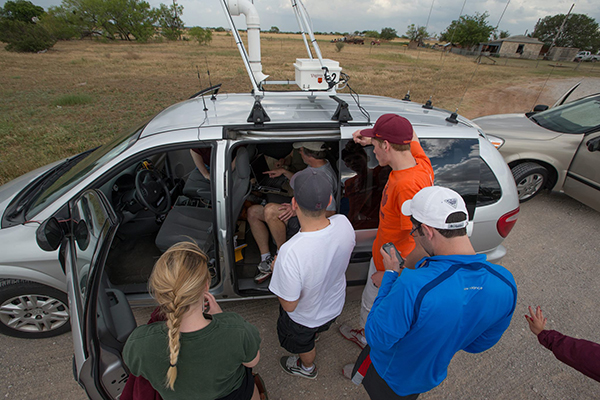
by Nick Luchetti Friday, June 21, 2013

Virginia Tech instructor Dave Carroll teaches students about base reflectivity radar as the group waits for a storm to initiate. Trevor White
In this series of three posts, Nick Luchetti, an undergraduate meteorology student at Virginia Tech, describes the thrills and emotions he experienced while chasing supercell storms and tornadoes in the Great Plains this past spring. Read the first post here.
The Intercept
Getting positioned in the correct spot to view a tornado is far more difficult than you might think. The part of a rotating supercell in which a chase team attempts to position itself is called the inflow notch — a part of the mesocyclone where air is pulled directly into the storm as it cycles. On radar, this area becomes apparent when a “hook” in the precipitation pattern begins to develop. The mesocyclone whirls precipitation around the back side of the rotation, which is clearly seen on radar.
To see a tornado, the team needs to be in perfect position with the inflow notch in view, where visibility is high. Most storms move northeast. Thus, we try to position ourselves to the east and north of the storm, and based on storm motion and speed, we decide if our current position is sufficient to get a glimpse of the inflow notch. If we need to shift location, we find the appropriate routes and then reposition ourselves. As we found out, even being in what should be exactly the right position does not guarantee you’ll witness a tornado.
The Mesocylone
The rotating mesocylone is visible in the part of the storm known as the rain-free base. Here, a lowering/rotating cloud base, known as a wall cloud, can form. If a tornado is going to drop, it will be from this lowered cloud base.
Supercells cycle air, essentially inhaling and exhaling. You can feel the wind whipping at your back as it is sucked into the area of low pressure in the storm. Eventually, what is known as the rear flank downdraft whips around the backside of the mesocyclone, which can be felt as the winds change direction and you’re hit either with noticeably warmer air or noticeably cooler air. Warm rear flank downdrafts are believed to be more conducive to tornado genesis. The supercell will progress through this inflow/rear flank downdraft cycle several times throughout its life, and during this cycle, tornadoes may stretch to the surface.
The unpredictable nature of downdraft cycles is what makes studying tornadoes so difficult. On top of that, storm chasers have to keep up with moving storms, which can become difficult if travelling in areas with limited road networks. Luck certainly comes into play. Additionally, mesocyclones can sometimes be obscured by rain in high-precipitation supercells, adding further difficulty and danger to in-person tornado research.
Supercell intercept near Hays, Kan.
A massive, aqua-green, destructive monster covers the entire sky. It looks like an alien invasion is occurring. I look toward the storm’s rain-free base. The glowing Kansas horizon shines through as the beautiful wall cloud lowers over a road leading to nowhere. A gentle rain shaft forms to the left of the storm. I watch in awe as chills run down my spine. To my right, a scary, destructive machine wreaks havoc, but directly ahead is the most beautiful, clear scene. It’s an image I’ll never forget.
Meanwhile, I feel the rush of air at my back and out of the corner of my eye flashes the craziest lightning you can imagine. Suddenly, the wind halts as the storm waits to exhale. All I hear is silence, followed by the chirping of birds. I was immersed in the most beautiful experience of my life. Then just as suddenly, screeching tornado sirens in the distance bring me back to reality as the storm moves toward town.
© 2008-2021. All rights reserved. Any copying, redistribution or retransmission of any of the contents of this service without the expressed written permission of the American Geosciences Institute is expressly prohibited. Click here for all copyright requests.